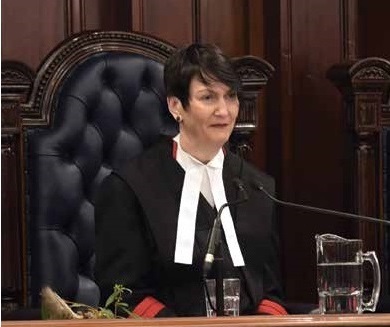 Do you need guidance on how to address a judicial officer of the Supreme Court of Victoria? This page makes it easy to know what to call a judge, associate judge or judicial registrar.
Do you need guidance on how to address a judicial officer of the Supreme Court of Victoria? This page makes it easy to know what to call a judge, associate judge or judicial registrar.
If you are looking for details on how to address a judge, magistrate or tribunal member in another court or tribunal, download the What do I call the judge? guide.
What do I call the judge?
In court
When speaking to a Supreme Court judge or associate judge, address them as ‘Your Honour’. If you are in court and called to address the judge, you should stand when you are spoken to or when speaking to them.
| Chief Justice | Your Honour |
|---|---|
| President of the Court of Appeal | Your Honour |
| Judge (including Judges of Appeal) | Your Honour |
| Associate Judge | Your Honour |
| Judicial Registrar | Judicial Registrar |
Outside court
What you call judicial officers outside court will depend on the occasion.
At formal social occasions, use the member’s position followed by their surname. For example, 'Justice Brown'.
It can be difficult to know the correct etiquette when speaking to judicial officers at informal social occasions. If you are unsure, 'Sir' or 'Madam' or 'Judge' are all acceptable. If in doubt, you can always ask them.
| Chief Justice | Chief Justice |
|---|---|
| President of the Court of Appeal | President surname |
| Judge (including Judges of Appeal) | Justice surname |
| Associate Judge | Associate Justice surname |
| Judicial Registrar | Judicial Registrar surname |
In writing
When addressing a judicial officer in writing, include their position and surname. In some circumstances, you can also use their title, such as 'The Honourable' or 'His/Her Honour'.
On envelopes, name tags and similar identifiers for events, full titles are used. You also include any honours (post nominals) the person holds after their surname.
Supreme Court of Victoria Address |
When writing a letter to a member of the Court, use their position followed by their surname. For example, 'Dear Justice Matoulas'.
| Addressing an envelope | Beginning a letter | |
|---|---|---|
| Chief Justice | The Honourable Chief Justice surname | Dear Chief Justice |
| President of the Court of Appeal | The Honourable Justice surname, President of the Court of Appeal | Dear Justice surname |
| Judge (including Judges of Appeal) | The Honourable Justice surname | Dear Justice surname |
| Associate Judge | The Honourable Associate Justice surname | Dear Associate Justice surname |
| Judicial Registrar | Judicial Registrar surname | Dear Judicial Registrar surname |
If you are part of a legal team, a witness or a party, you should avoid speaking to the judge, except in the courtroom. You should also avoid writing to them.
Retired judges
Many retired judges keep a title based on the position they held at the Court. When speaking to a retired judge, as a courtesy you can use the title 'Judge'.
Generally, retired judges of the Supreme Court keep 'The Honourable' as part of their formal title. For example, 'The Honourable Savitri Drake' would be used to address an envelope or similar stationery. To begin a letter, as a courtesy you use 'Dear Justice Drake'.

If you are looking for guidance on how to address a judge, magistrate or tribunal member in any Victorian court or tribunal, download the What do I call the judge? guide.
The publication includes details on addressing members of the:
- Supreme Court of Victoria
- County Court of Victoria
- Magistrates’ Court of Victoria
- Children’s Court of Victoria
- Coroners Court of Victoria
- Victorian Civil and Administrative Tribunal
- High Court of Australia
- Federal Court of Australia
- Federal Circuit and Family Court of Australia (Division 1)
- Federal Circuit and Family Court of Australia (Division 2)
